Working in aerospace is not a job, it’s a passion. At Extrude Hone we have shared this passion for aerospace since the early 1960s. We focus on our core technologies whilst innovating and adapting to apply them to new manufacturing processes, new geometries and new challenges. Our technologies have been embedded first on earth, then they moved to the air and now they are making it to the space. What a journey!
Up in the Air
It’s not a surprise that you will find on aerospace (either aeronautics (earth atmosphere flight or astronautics (space travel)) component drawings the wording “Extrude Honing” when it comes to surface improvement and edge radiusing. AFM – Abrasive Flow Machining was and still is the go-to process for these applications. Not only is it doing the job but also at a reasonable cost for the benefits and the value added. As we claim: “It’s not done until it’s finished with Extrude Hone”.
That could sound presumptuous, but it’s not, it’s about being proud of the job we do, and that claim is backed up by thousands of applications just in aeronautics and now also within 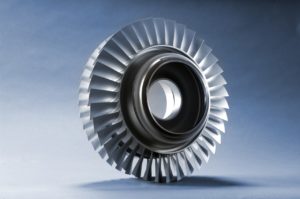 the space industry. I know this editorial could sound familiar to seasoned aero professionals, but we have new generation of engineers coming on board every year, and it’s still good to have a nice refresher.
the space industry. I know this editorial could sound familiar to seasoned aero professionals, but we have new generation of engineers coming on board every year, and it’s still good to have a nice refresher.
Extrude Hone offer has expanded through the years adding ECM- Electrochemical Machining and TEM Thermal deburring bringing these technologies to the aerospace industry.
Let’s go back to the original process we have built the company on. Abrasive Flow Machining is the perfect solution to improve surface for air flow components, working in the direction of the flux and decreasing original roughtness in an average of 10 times depending of the material. Suitable for most aerospace alloys it has the specificity to process even not reachable by hand areas. That’s why AFM is perfectly suitable for all impellers, vanes segments, nozzles and all kind of intricate manifolds. Many of these components are now increasing manufactured using additive layer and then polished with AFM.
Why use a fixture?
We often get the question of the fixture, why use a fixture? Some parts like a simple extrusion die is by itself the fixture, you nearly just need to clamp the part between the machine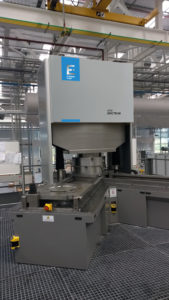 cylinders and just circulate the media. Manifolds to an extend are as well the part and the fixture as we can connect pipes to the manifold to pump the media through the passages we wish to polish and/or deburr. Impellers, even closed ones, would required fixture to drive and contain the media in the working area.
cylinders and just circulate the media. Manifolds to an extend are as well the part and the fixture as we can connect pipes to the manifold to pump the media through the passages we wish to polish and/or deburr. Impellers, even closed ones, would required fixture to drive and contain the media in the working area.
The principle is to raise the media pressure at the surface you want to process. A large turbine disk where you want to radius slot edges would require a large fixture to totally enclose the part and usually with a flaring zone to drive the media to the outer diameter of the disk on both sides enabling alternate flow from top to bottom and reverse.
But not all potential AFM applications are for large components. We can find a lot of hydraulic valves and tiny pipes. The beauty of processing smaller parts is that you can process several at once.
We have production in our contract shop where we process millions of parts a year using AFM.
Running costs are a key element of our process
The other question we often get asked is about running cost, especially about the consumable polishing compound called media. It’s a key element of the process and it needs to be 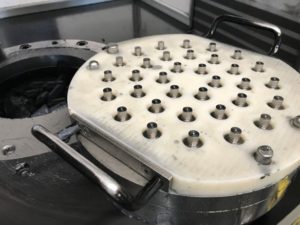 handled with care so you can get the best of its expected life span. We equip our machines to monitor multiple parameters that allow us to manage the media efficiency and to compensate the natural wear and efficiency decrease to the point you will need a fresh batch. We share technical process instructions with customers to optimise media use and provide training to ensure that newbie mistakes are avoided. The training can cover topics from basic good storage practice of the consumable through to process parameters optimisation.
handled with care so you can get the best of its expected life span. We equip our machines to monitor multiple parameters that allow us to manage the media efficiency and to compensate the natural wear and efficiency decrease to the point you will need a fresh batch. We share technical process instructions with customers to optimise media use and provide training to ensure that newbie mistakes are avoided. The training can cover topics from basic good storage practice of the consumable through to process parameters optimisation.
Some people are concerned the process may be dirty or oily. The process is clean. We have reached nearly fully automated production for above mentioned applications some with production rates in the millions. We have also developed oil free media which can replace a good portion of existing one making AFM production cleaner and more friendly. We have also innovated with machine design and fixture design to keep the process clean and production optimized.
If jet engines, commercial or military and helicopter turbines performed at their best and safely it’s in part thanks to Extrude Hone AFM.
The big shift to additive components
We have seen this coming and we knew we had an ace in our sleeve. Because we can design our media abrasive power to match the application and the material, it was no surprise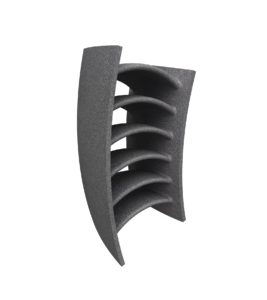 that Extrude Hone came at the top of the list for qualified finishing processes for the new challenge of improving the poor surface quality of additive manufacturing including EBM ones. When talking of internal passages there was no debate, as by nature AFM process would be the solution, especially if you do not want to handle all the safety and environmental concerns of acid-based processes…
that Extrude Hone came at the top of the list for qualified finishing processes for the new challenge of improving the poor surface quality of additive manufacturing including EBM ones. When talking of internal passages there was no debate, as by nature AFM process would be the solution, especially if you do not want to handle all the safety and environmental concerns of acid-based processes…
We even pushed the boundaries to leverage our knowledge in fuel systems flow tuning to apply AFM or MICROFLOW (extreme low viscosity) to finish new generation of helicopter injection nozzle and some Cyclonic Doublet inducer. For injection application we could go as far as calibrating the flow to permit a better combustion meaning less fuel and less emission.
Manifolds are in the spotlight of the additive industry, as you can do organic design and pack more functions in less space it means reduced weight – a key factor
in aerospace – but with the added challenge of internal passage finishing. As people are less inclined to use acid for finishing, AFM remains the mainstream 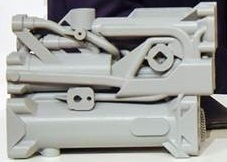 solution. As part of the design process we push to be involved in, we make sure we build in connecting ports for AFM media hoses, the port can be removed if not part of the final components when we cannot leverage existing ones and the part is usually better processed when still having all structure supports.
solution. As part of the design process we push to be involved in, we make sure we build in connecting ports for AFM media hoses, the port can be removed if not part of the final components when we cannot leverage existing ones and the part is usually better processed when still having all structure supports.
Thickness of the wall is one last thing you would need to look at as temptation is huge to go too far in saving space a finally design something that cannot be finished. And you know: “It’s not done until it’s finished with Extrude Hone.”
We are finishing manifolds for the top OEM’s in the Industry using ECM – Electrochemical Machining. As an example, we have been working with Dassault for many years as ECM is a solution of choice to ensure top notch quality of their manifolds. Imagine 248 areas processed in 5 minutes through 3 step process. Leaving no chance for any burrs to be left behind and insuring key areas geometries with nice specific rounding features. Some people would say expensive, but I would ask them the cost of having dozens of people undertaking manual deburring with all the risk of missing a point or destroying a high value component. And I would add that for large commercial OEM’s supplier producing hundreds of aluminum manifolds it goes also with the ability to scale up production.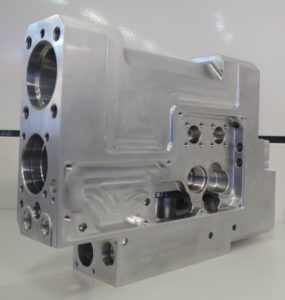
The aerospace industry have been reluctant to adopt TEM – Thermal deburring for years. After years fighting, sometime against myths, we finally see TEM penetrating the aerospace industry. I’m not yet talking about critical engine components but for some other simple parts, that’s the way to go for overall deburring at high productivity and low cost.
In the air – and beyond
While we see the traditional aerospace market slowing down possibly for the upcoming two years or so, we have great hope regarding the satellite industry business. From launcher components to satellite wave guide there is a whole new array of components to be finished. At Extrude Hone we have quickly embraced the move and are happily participating in this journey. This market is at the leading edge combining new business plan with new products including many which are additive made, with new finishing challenges. It’s also an industry where new comers move quite fast and are quick to adopt disruptive solutions. When looking at finishing process, they want something that works now and they do not bother too much about history.
I hope this Extrude Hone insight leaves you with a good sense of our capabilities. For the time being, if we do not have a chance to be side by side in an aero event in the next months, we still have a chance to talk face to face in this digital age, so do not hesitate to reach out to us.
The master technology of AFM – Abrasive Flow Machining

